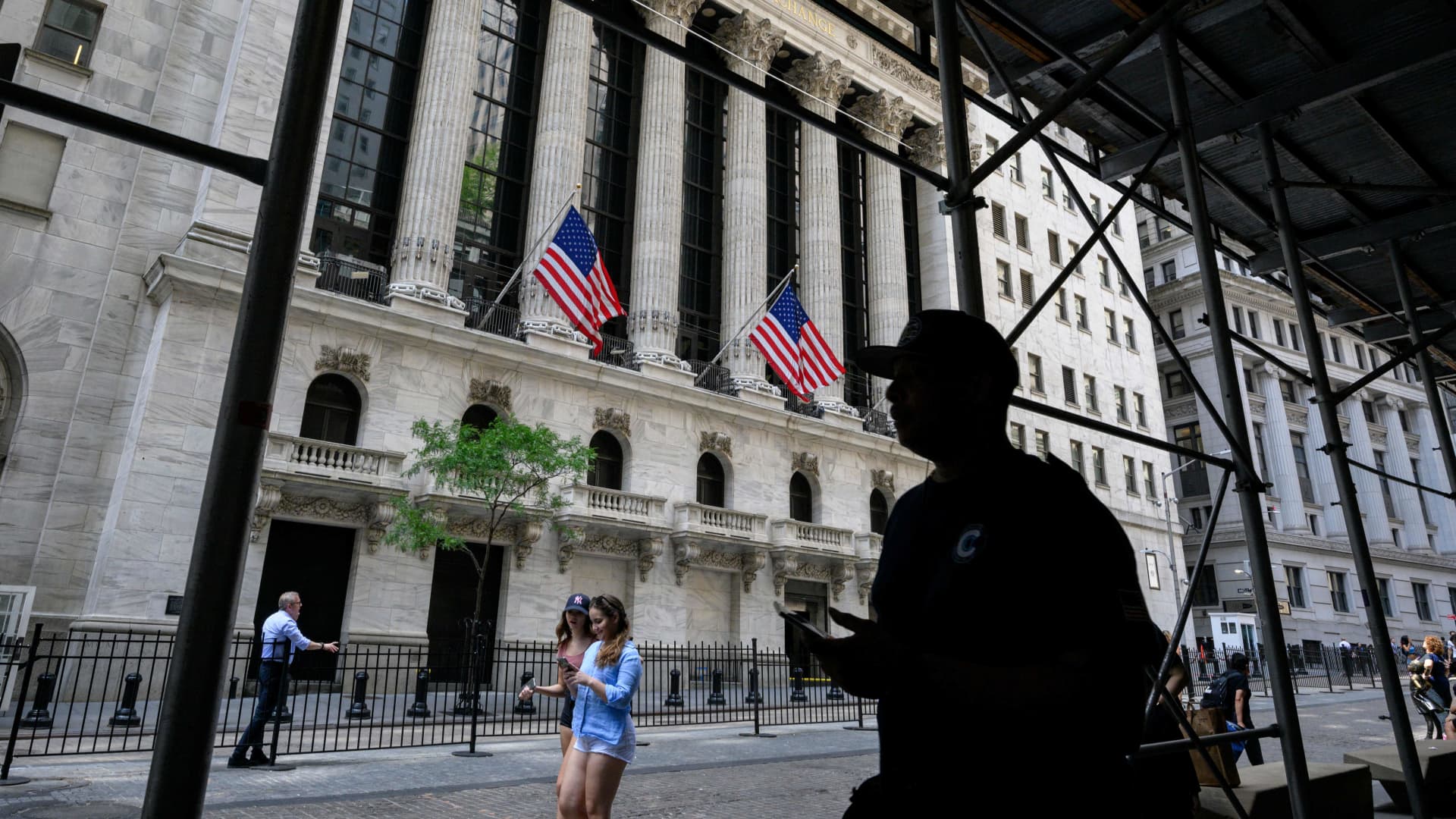We’re adding four stocks to our Bullpen, including Starbucks and Airbnb


We’re adding four stocks to our Investing Club Bullpen, including Starbucks (SBUX) and Airbnb (ABNB). Jim Cramer announced them in Thursday’s “Monthly Meeting.” The Bullpen should be treated like a watch list of sorts and an outside area to perform homework and due diligence. As the baseball metaphor suggests, it consists of stocks in reserve that we might consider buying and adding to our portfolio. The Bullpen is a collection of stocks identified by the Club team as having the potential to join Jim’s Charitable Trust, whose holdings serve as our portfolio. These are companies we view as high quality and will monitor outside the current portfolio. We’re analyzing and looking for opportunities to buy these stocks, but there’s no guarantee when, or if, we’ll initiate a purchase. Also, adding a stock to the Bullpen does not necessarily mean we would buy it at the current price. Before initiating a position, we are typically waiting for either certain events to unfold — both company-specific and macro-oriented — or a more attractive entry point. The current makeup of the portfolio may also delay an initiation in order to keep it diversified. First up, Starbucks. We were in SBUX previously and made a lot of money on it. We sold in May 2021 at around $110 per share. That was near its all-time high of just over $126 in July 2021. This past May, SBUX hit a 52-week low at $68.39 and closed Wednesday at $87.27. Now we are thinking about getting back after hearing more and more about the improvements that founder and interim CEO Howard Schultz is making to the business. Keep in mind, one of the first things Schultz did when he returned as CEO was suspend the buyback. Shareholders may have groaned about this at first, but it looks like this decision was made for a great reason. Starbucks believes buying back shares returns, on average, about 10%. Schultz does not believe a 10% return on that capital is enough. So instead of buying back stock, Starbucks is increasing investments in the business — innovation around technology and personalization. Accelerating new store growth with a focus on drive-throughs is one. Another is investments to improve efficiencies, speed of service. In essence, Schultz wants to make it a better place to work and to visit. The big debate is, what impact on margins will these investments have? Of course, near-term margins will be limited by this increase in spending. But longer term, Starbucks believes the investments will pave its way to a stronger, more profitable growing company. At the company’s investor day in September, Schultz plans to showcase how accretive to the business this reinvention plan will be, setting up Starbucks for a strong FY23 and beyond. It also helps that the company reported earnings Tuesday night and the results look strong, with North America comparable sales up 9% with ticket growth up 8%. Importantly, Starbucks has not seen any trade down at its stores, as it appears that the daily routine of buying Starbucks coffee is something people do not want to give up. I also liked hearing about the huge opportunity the company sees in cold beverage, which makes up 75% of total beverage sales in the United States. China is obviously a question mark as COVID-19 mobility restrictions and limits on in-store dining have hurt business, but trends immediately improved following Shanghai’s reopening in early June. The stock isn’t exactly cheap at 27x earnings, but you have a few potential catalysts on tap. The Investor Day, the naming of a new CEO and a China reopening. Jim believes that Schultz is a master. While happy if the stock comes down to $82, with potentially some more downside, Jim thinks SBUX would still be a winner at $87. Palo Alto Networks is a one-stop shop for enterprise customers looking to bolster their cyber defenses, offering old-school hardware solutions, new-age cloud-based products and fully-managed solutions, which allow you to toss the keys to their teams of experts and let them create and manage your cybersecurity infrastructure. It’s especially important to note that cybersecurity is an industry we don’t want to skimp out on, considering that there are so many concerns about cyber attacks from Russia and China, as well as crypto hackings, that could send stocks in the sector higher. When the company reported its most recent earnings in May, it delivered yet another set of excellent results, topping expectations on every line and issuing better than expected guidance for the next quarter. Billings increased 40% year over year, the highest growth rate the company has ever reported over the past four years. What’s so impressive about this figure is that it came during a time when many people feared corporations would have to slash their IT budgets in preparation for the economic slowdown. But if we have learned anything from the increase in cyberattacks since the start of the pandemic, it’s that cybersecurity is one of the most important areas for corporations to invest in. But this isn’t a company that has a sole focus on growing revenues as fast as possible. Management is doing an excellent job at balancing top line growth with profitability and cash generation. The company is committed to 50 to 100 basis points of operating margin expansion and 100 to 150 basis points of adjusted cash flow margin expansion from fiscal ’22 through ’24. The company just wrapped up its fiscal ’22 year in July. Shares of Palo Alto Networks are not cheap on earnings, but the company is currently estimated to reach full year GAAP profitability in fiscal year 2023. If they deliver on what is expected, this could bring in a whole bunch of new investors into the stock who previously stayed away. If you are looking to add real growth to your portfolio, then this could be the type of new name to target on those crazy days where everything is selling off indiscriminately. We believe the stock would be a buy if it goes down another $20 or $30 per share, perhaps down to $475. The stock was down 6% on Thursday, so things could be going our way. Airbnb is an interesting one. This is a tech company whose peer-to-peer home rental platform is disrupting the lodging industry. It’s definitely on the higher risk side because the stock is expensive by traditional valuation metrics, but the company has done a great job balancing growth with profits, working to reduce fixed costs and improve variable costs. It also helps that we are currently in a travel boom. But I have to say, the results the other night were pretty mixed. While some operational metrics like Nights Booked and Gross Booking Value fell short of expectations, Revenue was in-line and the company’s earnings results – both Net Income and Adjusted EBITDA – were well ahead of the consensus estimates. And typically, the company delivers really strong free cash flow, but it missed this time around. More importantly, I thought ABNB provided a good outlook for the future, noting that it has seen growth in nights booked reaccelerate from June to July. That’s big, because one bear case against the stock is that a recession will cause a pullback in travel. The company did speak of some cancellations near the end of the quarter, but that was mostly due to flight cancellations. Also keep in mind that one bedroom alternative accommodations like ABNB are cheaper than hotel rooms, and more people may become hosts if they need supplemental income. Also, if cross-border travel becomes too expensive for some, a shift towards more domestic trips actually plays into its favor because its average daily rates are highest in its two largest regions, the United States and Europe. So ABNB should continue to be a market share gainer in a slowdown. The company also announced a $2 billion share repurchase program. That’s a great sign of confidence in the future cash flows. However, we are not considering purchasing shares of ABNB anytime soon, considering its jump from $90 to $118 per share in just the last couple days. Remember, stocks in the Bullpen aren’t guaranteed purchases for the Club — they’re simply high quality companies we have our eye on. We are always on the hunt for stocks that offer a combination of value, yield and growth. For any investor who wants to remain in the market but wants security, yield and the potential for long-term growth, we’d suggest you check out Sempra Energy , a diversified utility and energy infrastructure play that owns a couple regulated utilities in California and Texas, as well as a large and growing portfolio of infrastructure assets, highlighted by natural gas pipelines and LNG export assets. It is easy to be a fan of Sempra Energy because it was a well-run utility with exposure to attractive markets, and further had upside from the infrastructure assets that include a network of pipelines that take natural gas from the U.S. to Mexico. But it is also interesting for its LNG export exposure, which includes one existing facility in Louisiana, and several more under development or consideration in Mexico and Texas. Meanwhile, the stock trades at a very reasonable 19x earnings, and pays a roughly 2.75% dividend yield that provides further downside protection, while the company returns even more cash to shareholders through regular buybacks. Here is the game plan for SRE as laid out in the “Monthly Meeting”: Let’s listen to the conference call. Remember that we don’t own a utility stock and should consider one to diversify our portfolio. Know that this is one of the fastest-growing companies among large utilities and the company intends to help solve the energy crisis in Europe. (See here for a full list of the stocks in Jim Cramer’s Charitable Trust.) — CNBC’s Krystal Hur contributed to this report. As a subscriber to the CNBC Investing Club with Jim Cramer, you will receive a trade alert before Jim makes a trade. Jim waits 45 minutes after sending a trade alert before buying or selling a stock in his charitable trust’s portfolio. If Jim has talked about a stock on CNBC TV, he waits 72 hours after issuing the trade alert before executing the trade. THE ABOVE INVESTING CLUB INFORMATION IS SUBJECT TO OUR TERMS AND CONDITIONS AND PRIVACY POLICY , TOGETHER WITH OUR DISCLAIMER . NO FIDUCIARY OBLIGATION OR DUTY EXISTS, OR IS CREATED, BY VIRTUE OF YOUR RECEIPT OF ANY INFORMATION PROVIDED IN CONNECTION WITH THE INVESTING CLUB. NO SPECIFIC OUTCOME OR PROFIT IS GUARANTEED.
This post has been syndicated from a third-party source. View the original article here.




